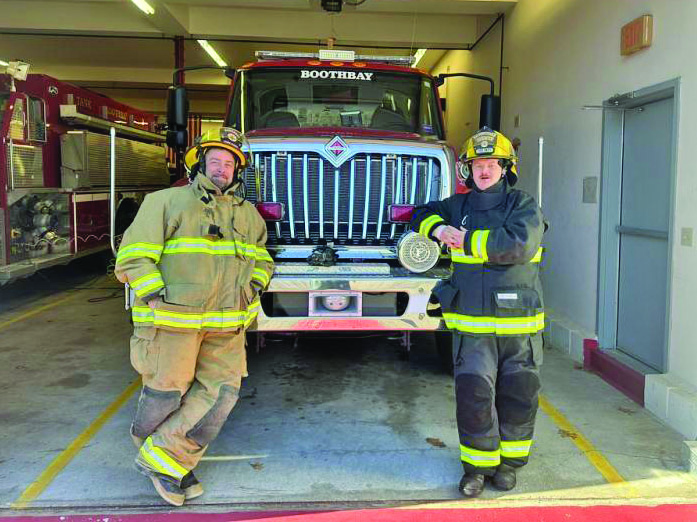Winter Storm Preparedness
With the Hurricane season now in our rear-view mirror (Hurricane season officially ends Nov. 30) our focus now intently shifts to the upcoming winter season. As all of us vividly recall, last year’s severe winter storms brought unprecedented destruction to the Maine coast, and in the Boothbay peninsula the storms destroyed critical infrastructure such as roads, power and water lines, and the electrical grid. Additionally, private and commercial structures were either severely damaged or destroyed, all adding up to tens of millions of dollars in losses and associated operational impacts.
While no one has a crystal ball in terms of how severe the upcoming winter season will be, preparing for winter and the associated storms is something that is in our control. From a fire department and first responder perspective, preparations are well underway at each department to ensure equipment is ready to go, training and emergency management plans are up to date and in place and inter agency communication is operational and tested.
For residents and commercial businesses, taking the time to develop your personal and company plans, and to check and validate that your safety equipment, generators and homes and businesses are fully tested and prepared for severe winter storms is a great first step.
The Federal Government has outstanding digital sites on disaster planning, preparedness and recovery – Ready.Gov (https://www.ready.gov/plan) and https://www.ready.gov/be-informed – which not only have key winter storm preparedness and recovery information, but also sections for all major natural and man-made threats, with a few illustrative examples such as hurricanes, floods, thunderstorms and tornadoes, cyber security, civil unrest and safeguarding critical documents and valuables etc. The site also contains tools you can use to create your own personal plans, and key support resources for additional information of where to turn to for help in the event of an actual disaster.
You can also order free preparedness materials from FEMA’s online ordering platform. https://orders.gpo.gov/icpd/ICPD.aspx. These materials can be shipped directly to you at no cost or electronically downloaded.
There are numerous sites which have excellent winter planning and preparedness information, including the following:
-
Winter preparedness: https://www.ready.gov/winter
-
Red Cross Winter Preparedness Checklist: https://tinyurl.com/4f7fa2pf AND https://tinyurl.com/4a39dnpr
-
NOAA Winter Preparedness site https://tinyurl.com/yv6ax474
-
FEMA in-depth guide to citizen preparedness: https://tinyurl.com/4vnpnua8
It is important to understand the types of winter storms we can have, and the differences between watches and warnings.
Watches - a watch is generally issued in the 24 to 72 hour forecast time frame when the risk of a hazardous winter weather event has increased (50 to 80% certainty that warning thresholds will be met). It is intended to provide enough lead time so those who need to set their plans in motion can do so.
Advisory – these are issued when a hazardous winter weather event is occurring, is imminent, or has a very high probability of occurrence (generally greater than 80%). An advisory is for less serious conditions that cause significant inconvenience and, if caution is not exercised, could lead to situations that may threaten life and/or property.
Warning - These are issued when a hazardous winter weather event is occurring, is imminent, or has a very high probability of occurrence (generally greater than 80%). A warning is used for conditions posing a threat to life or property.
There is an excellent site that describes the types of winter storms, such as blizzards, types of extreme cold situations along with a host of digital resources that allow you to learn more and prepare at https://www.weather.gov/bgm/winterterms
Being prepared, and taking actions now can prevent more serious situations from occurring. Did you know that sixty-three percent of temperature-related deaths are attributable to cold exposure and home heating is the second leading cause of home fires, and winter is when most home fires happen?
Winter Storm Planning, Preparedness & Recovery
--Develop a winter storm plan, which describes what you or your business needs to do to prepare, and actions to take should a serious event occur. Preparing is invaluable to keep you and your family safe, and can help prevent or reduce financial loss or damage
--Before the winter season begins, make sure you can heat your home, apartment or business safely. Prepare your home to keep out the cold with insulation, caulking, and weather stripping.
--Clean fireplaces and wood stove flues.
--Check all critical equipment, such as portable generators to ensure they are in good working condition. Check that you have related fluids such as oil, anti-freeze and fuel for extended power outages. Use fuel stabilizer for gas powered generators.
--Determine your greatest risk potential: loss of heat, frozen pipes, and/or loss of access due to snow/ice. Gather food, water, and medicine before a winter storm.
--Identify who is responsible for keeping heating equipment in good working order: home resident, business owner or landlord.
--Create a Go Kit: 3 days supplies, medicines, personal and financial info, etc.
--NEVER drive over downed power lines. Your car does not protect you from electrocution.
--NEVER drive through flooded roads. Six inches of water will reach the bottom of most passenger cars, causing loss of control and potential stalling. A foot of water will float many vehicles.
--NEVER run a portable generator in a home, garage or any building. CO2 is a silent, orderless killer.
--Should you become trapped or need help, if in doubt call 911. Maine has an outstanding 911 systems, and we can pinpoint your exact location through GPS and GEO location capabilities.
--Plan to check on loved ones and neighbors to make sure they are staying warm.
As you may recall in our earlier chief’s column this summer, we profiled firefighters Andrea Hodgdon and Gareth Hodgdon, the dynamic mother/son team serving on Boothbay Fire & Rescue. I’m very proud to highlight another great family team, with Firefighter Mike Godleski and his stepson Xavier Downing.
Mike joined our department about a year and a half ago, and recently completed his Basic Firefighting course, allowing him to conduct interior firefighting. Mike, who is an electrician, has graciously donated his time to install the new Kohler Backup Generator for our Central Station, which has saved the town thousands of dollars. Xavier, who followed his stepfather's path, recently joined the department a year ago, and is now enrolled in an advanced six-month long Firefighter course. Mike and Xavier have already worked hundreds of hours as volunteers serving our department and community, and we are thankful for their commitment to serve with purpose and pride.
On behalf of the women and men of Boothbay Fire & Rescue, Happy Thanksgiving, and we hope you have a wonderful day with family and friends. We are very grateful for the support of our community, and we could not do what we do without you.
Mike Godleski
Years at Boothbay Fire: 1.5 years
Role: Firefighter
Full-time employer: Owner/operator After Hours Electric
Why did you join the fire service: It was something I have always wanted to do and now that I work for myself, I feel I can make the time to do it. I moved to Boothbay in 2015 and wanted to do something to be more involved and give back to the community that has welcomed me.
What do you like best: Helping people when things seem to be at their worst. It feels good to know this group of men/women will be there to help with whatever needs to be done.
What have you learned since joining: Being a volunteer fireman is a lot more than just fighting fires. Since joining -- pumping out flooded basements, traffic control, heavy lift assist of ill or injured patients, how to safely drive and operate fire trucks, and how to fight fires.
Xavier Downing
Years at Boothbay Fire: 1 year
Role: Firefighter
Full-time employer: After Hours Electric
Why did you join the fire service: It has always been something I've been interested in. My dad is a firefighter so I was around it all the time as a kid and always had a good time hanging around the station. My stepdad, Mike, joined before me so that also pushed me to joining and I grew up here so it’s a way for me to help the community that raised me.
What do you like best: It’s a very dynamic and unpredictable job with every call being different. I enjoy helping others and if I can make a difference in an emergency then that can feel rewarding and like I’m making a positive difference.
What have you learned since joining: I learn something new every time I go to the station or on a call. It’s a job of continuous learning and skill development, especially with new technology. There is a lot that goes into it and that makes for lot of skills that you need to learn and be proficient in. I’d say that it has also increased my awareness and preparedness in everyday life. I’m excited to continue learning and take classes to better serve this community., or surge protectors, developing a family plan for an emergency, etc.

























